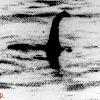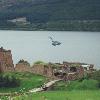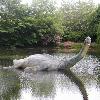

The Loch Ness Monster is a cryptid that is reputed to inhabit Loch Ness in the Scottish Highlands. The most frequent speculation is that the creature represents a line of long-surviving plesiosaurs. It is similar to other supposed lake monsters in Scotland and elsewhere, though its description varies from one account to the next.
Popular interest and belief in the animal has fluctuated since it was brought to the worlds attention in 1933. Evidence of its existence is anecdotal, with minimal and much-disputed photographic material and sonar readings. The scientific community regards the Loch Ness Monster as a modern-day myth, and explains sightings as a mix of hoaxes and wishful thinking. Despite this, it remains one of the most famous examples of cryptozoology. The legendary monster has been affectionately referred to by the nickname Nessie (lang-gdNiseag) since the 1950s.
Creature Name: Loch Ness Monster
Sub Grouping: Lake monster
Aka: Nessie ,Niseag (Scottish Gaelic) ,The LNM ,"Nessiteras rhombopteryx"
Region: Loch Ness
Grouping: Cryptid
Habitat: Water
First Reported: 565 (retrospectively),,1933 (chronologically)
Last Sighted: 2009




